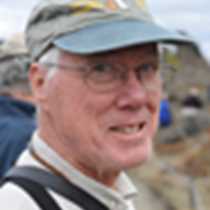Isla San Jose, the Gulf of California
A day that begins with blue whales is sure to be a good day! Following our departure from humpback whales yesterday evening we went north in the Gulf of California in search of further adventures. Even before breakfast we spotted a blue whale feeding in the productive waters on the east side of Isla San Jose. Each surfacing was signaled by a tall, columnar blow, then a mottled blue-gray back … back … back … more back … and finally the small dorsal fin set just in front of the massive flukes. We were in the presence of the largest animal on earth, the largest animal known to have ever existed. We were not alone in enjoying the presence of this magnificent whale. Bottlenose dolphins were riding on the pressure wave created as the giant head moved through the water, a behavior that, presumably, is the origin of dolphins’ habit of riding the bow wave of ships like ours. Our unquantified impression is that people on boats enjoy the behavior more than the whale.
Our morning excursion was at Punta Colorado (“Red Point”). While most of Isla San Jose consists of granite, Punta Colorado is an exposure of brilliant red sandstone, its marine origin indicated by the presence of numerous shells embedded in the rock. This soft stone has been worked by the erosive forces of wind and water, sculpted into strange shapes and swirls. We walked up a desert arroyo, the red of the sandstone contrasting with vegetation made green by recent rains: cholla cacti adorned with a dense covering of spines; thorny Palo Adan sporting new sets of green leaves and just putting out their red flowers to attract hummingbirds for pollination; desert vines of several species sprawling over the bushes; and small desert annuals adorned with flowers, rushing to complete their life cycles before the water is exhausted and the desert returns to sere quiescence.
Following lunch came a special treat … a visit to a small and isolated island fishing community on the tiny island of El Pardito. Here an extended family has made their living from the sea for four generations. The five residents now on the island (others are in La Paz taking their dried and salted fish to market) made us welcome, sharing stories of their lives so different from ours.
This wondrous day concluded at Isla San Francisco with walks over the desert and an exploration of the diversity of animal life found in tide pools exposed by the low tide of a full moon. Some returned to the island following dinner to bask in the warmth of a beach fire and admire that full moon and the bright stars of the desert sky.
A day that begins with blue whales is sure to be a good day! Following our departure from humpback whales yesterday evening we went north in the Gulf of California in search of further adventures. Even before breakfast we spotted a blue whale feeding in the productive waters on the east side of Isla San Jose. Each surfacing was signaled by a tall, columnar blow, then a mottled blue-gray back … back … back … more back … and finally the small dorsal fin set just in front of the massive flukes. We were in the presence of the largest animal on earth, the largest animal known to have ever existed. We were not alone in enjoying the presence of this magnificent whale. Bottlenose dolphins were riding on the pressure wave created as the giant head moved through the water, a behavior that, presumably, is the origin of dolphins’ habit of riding the bow wave of ships like ours. Our unquantified impression is that people on boats enjoy the behavior more than the whale.
Our morning excursion was at Punta Colorado (“Red Point”). While most of Isla San Jose consists of granite, Punta Colorado is an exposure of brilliant red sandstone, its marine origin indicated by the presence of numerous shells embedded in the rock. This soft stone has been worked by the erosive forces of wind and water, sculpted into strange shapes and swirls. We walked up a desert arroyo, the red of the sandstone contrasting with vegetation made green by recent rains: cholla cacti adorned with a dense covering of spines; thorny Palo Adan sporting new sets of green leaves and just putting out their red flowers to attract hummingbirds for pollination; desert vines of several species sprawling over the bushes; and small desert annuals adorned with flowers, rushing to complete their life cycles before the water is exhausted and the desert returns to sere quiescence.
Following lunch came a special treat … a visit to a small and isolated island fishing community on the tiny island of El Pardito. Here an extended family has made their living from the sea for four generations. The five residents now on the island (others are in La Paz taking their dried and salted fish to market) made us welcome, sharing stories of their lives so different from ours.
This wondrous day concluded at Isla San Francisco with walks over the desert and an exploration of the diversity of animal life found in tide pools exposed by the low tide of a full moon. Some returned to the island following dinner to bask in the warmth of a beach fire and admire that full moon and the bright stars of the desert sky.




